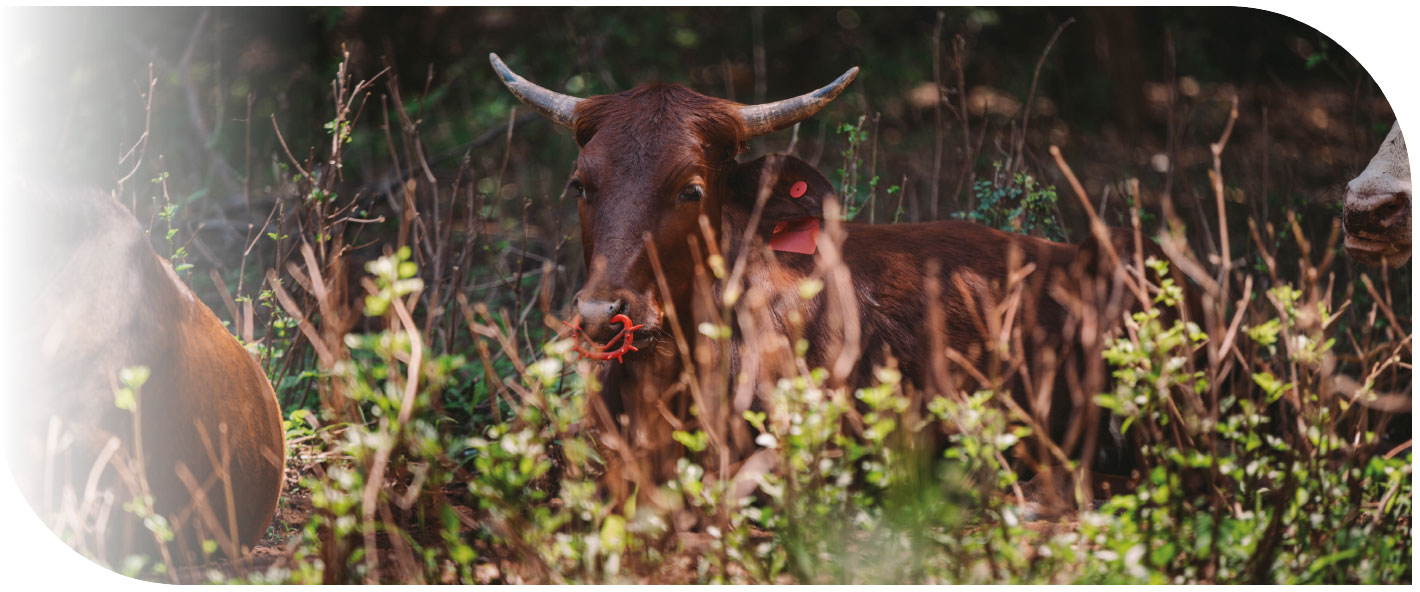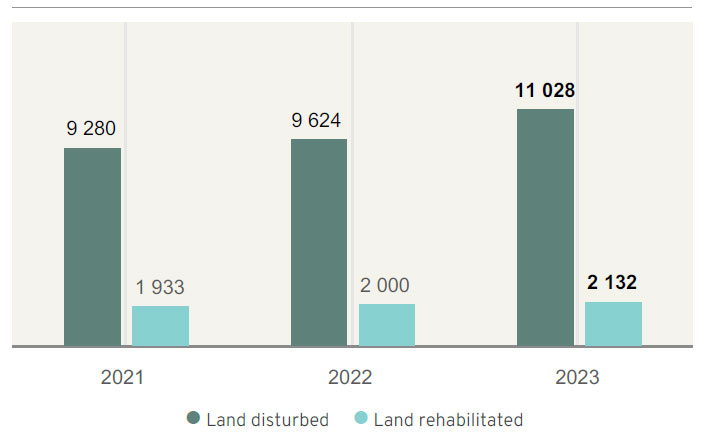Currently viewing: Mine closure and rehabilitation | Next: Waste management
Our integrated closure planning and concurrent rehabilitation will ensure we leave a sustainable post‑mining legacy – building momentum throughout our operations' lifecycles as we work towards enhancing our positive impact and mitigating our negative impact.
Started rehabilitation at Durnacol dump 7 and Tshikondeni dump
Implemented KPI reporting
Engaged with government on Grootegeluk dumps 4 and 5 to finalise rehabilitation redesigns
To manage our environmental liabilities and rehabilitation in compliance with legislation and evolving responsible mining practices while uplifting our employees and communities with sustainable alternative land use
KPI: Physical rehabilitation (actual versus budget)
Our integrated closure planning and concurrent rehabilitation support the objectives of our Sustainable Growth and Impact strategy.
![]() Become a catalyst for economic growth and environmental stewardship
Become a catalyst for economic growth and environmental stewardship
Communities
To involve them in rehabilitation projects by appointing local contractors and social impact programmes
Government
To ensure our operations are compliant and all reports submitted
Minerals Council
To provide inputs on policies and GN 765 regulations and related legislation comments
Future focus
We plan to do the following:

We manage our environmental liabilities and rehabilitation in compliance with legislation and evolving responsible mining practices. Our holistic and integrated approach to land management, mine closure and concurrent rehabilitation* is unpacked on the next page.
In implementing this approach, we:
Annual environmental rehabilitation cost update
| Identify impacts and rehabilitation areas |
|
| Adjust tariffs and escalation |
|
| Separation of immediate and LoM cost |
|
| Calculation and prioritisation of concurrent liability |
|
| Scheduling of concurrent rehabilitation |
|
| Budgeting |
|
| Reporting |
|
We also aim to deliver on our closure and rehabilitation strategic objectives of:
Our approach aligns with our Social Impact strategy objectives by integrating the following principles:
Our sustainability managers, supported by the rehabilitation team and on-site environmental specialists led by the chief sustainable impact officer, oversee the implementation of our policy and practices. BUs take responsibility and accountability for concurrent rehabilitation and have site-specific rehabilitation procedures to follow.

*Mine rehabilitation is the restoration of the post-mined landscape to the intended post-mining land use.
We strive to integrate land and liability management in daily mine planning to minimise final closure costs for each operation and optimise final land use after closure.

Monitoring, measuring and reporting
Periodic environmental management programme performance assessments inform amendments to rehabilitation plans and closure objectives.
Social impact
To effectively and efficiently manage Exxaro-owned land to support current and future operations, assist with biodiversity offsets and create social impact, we categorise our land parcels as follows:
Our minerals succession programme (MSP) supports farmers by enabling access to resources (funding, mechanisation, inputs and training) in a three-year contract with an external service provider.
We are working towards transferring 90% of post-mining land to emerging farmers in local communities by 2026.
Employee engagement and development
Infrastructure
Assets
Financial
We annually review our mine closure and rehabilitation obligations and rehabilitation plans and closure objectives are amended after environmental management programme performance assessments. Cost estimates of activities in the concurrent and final closure rehabilitation programme are reviewed and adjusted. External auditors visit our sites, review documents and audit the environmental liability bi-annually. This highlights potential rehabilitation alternatives that could decrease the long-term closure liabilities of operations.
An external consultant reviews Cennergi's financial provisions for facility closure and rehabilitation every three years. Cennergi reviews and adjusts cost estimates for concurrent and final closure rehabilitation programmes as needed.
Exxaro's Environmental Rehabilitation Fund (EERF) and additional bank and insurance guarantees provide for new developments and cover shortfalls in financial provisions. The EERF's assets are managed in terms of asset and liability modelling aligned with risk, return and liability on each site. The objective is to maximise investment growth in the cost of liability provisions. An external specialist supports EERF trustees with technical skills required to profile and identify suitable structures for assessment by the trustees. Current implementation includes:
Community safety, health and job creation
Programmes, such as the MSP, aim to address health and safety issues as well as employment opportunities for communities.
Mining plan
Each BU has five-year conceptual concurrent rehabilitation plans, schedules and associated budgets to:
Safety and risk control
Health and safety at mines in closure is just as important as any operational mine. We apply the same health and safety standards and policies to all Exxaro's operations, including mines in closure. Security risks are a major challenge at any closed operation and infrastructure and assets need constant safeguarding during a closure process.
Interested and affected parties
Environmental stewardship
Exxaro's disturbed footprint includes buildings, roads and mining areas to be rehabilitated in terms of the environmental management programme and the final land use plan (when maintenance and monitoring are needed).

Operational guarantees at year end R3 552 million
(2022: R3 606 million)
Total unscheduled closure costs R9 327 million
(2022: R8 427 million)
Growth of Exxaro and Matla rehabilitation trust funds (combined) R244 million
(2022: R19 million)
Interest earned on investments and fair value adjustments.
Operations in active closure in 2023
Tshikondeni, Durnacol, Hlobane and Strathrae
(2022: four)

Hlobane: Sealing of cracks on the mountain was completed, and the Hlobane waterfall during every rainfall event

Matla: Crack sealing on subsidence areas was completed within two years, and local farmers were given access to the area for crop production. The water treatment plant has been operating successfully since 2016

Eerstelingfontein/Inyanda: Concurrent rehabilitation completed within one year after completion of mining activities

Belfast: Rehabilitation of the wetland system adjacent to mine was completed

Grootegeluk: Proof-of-concept study in the mining right area was completed and six seasonal pans were created

Tshikondeni: All rehabilitation completed within five years, with maintenance on discard remaining
Land disturbed versus land rehabilitated (ha)

Refer to the databook for more detail on land disturbed versus land rehabilitated.
The increase of 1 404ha in land disturbed is due to the inclusion of Mine 1 development at Matla as well as additional areas mined at the opencast operations at Grootegeluk, Leeuwpan and Belfast.
The increase in our performance of land rehabilitated of 132ha is due to increased rehabilitated land handed over to farmers at Matla to utilise.
The backlog in rehabilitation at Leeuwpan will be addressed in 2024 with a dedicated five-year budget to clear the backlog volumes on backfilling of pits.
Although the implementation date was set (19 February 2024), we await promulgation of draft financial provision regulations for mine closure and rehabilitation (GN 792) issued on 27 August 2021. Discussions continue between the environmental policy committee of the Minerals Council, on behalf of Exxaro and our mining peers, and the DMRE.
The proposed regulations will repeal GNR 1147. All our BUs will be continuously assessed according to GNR 1147. On 1 February 2024, the implementation of GNR 1147 was postponed indefinitely by government. The delays in government's implementation of GNR 1147 creates legislative uncertainty in the financial provisions for environmental rehabilitation areas.
 Report Index
Report Index